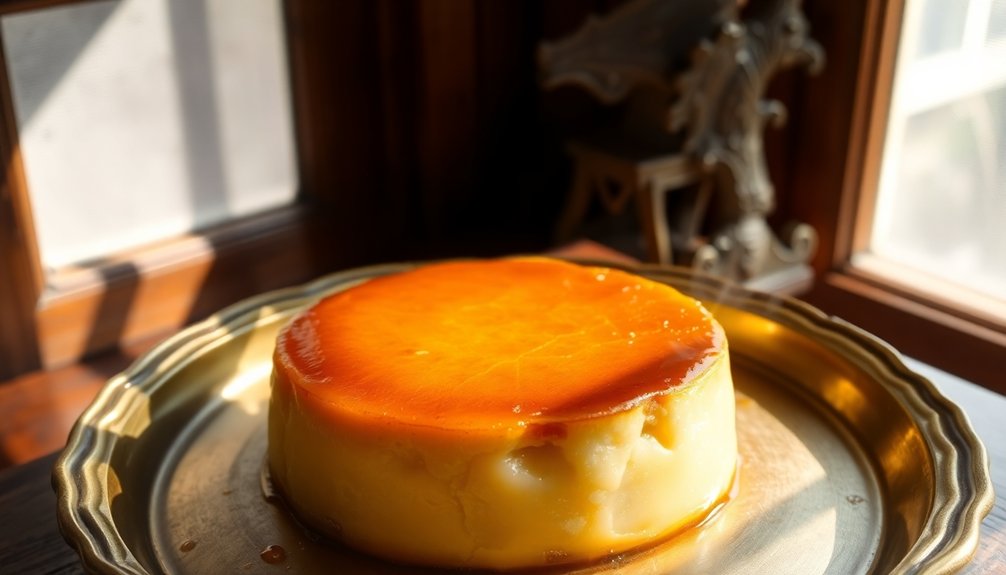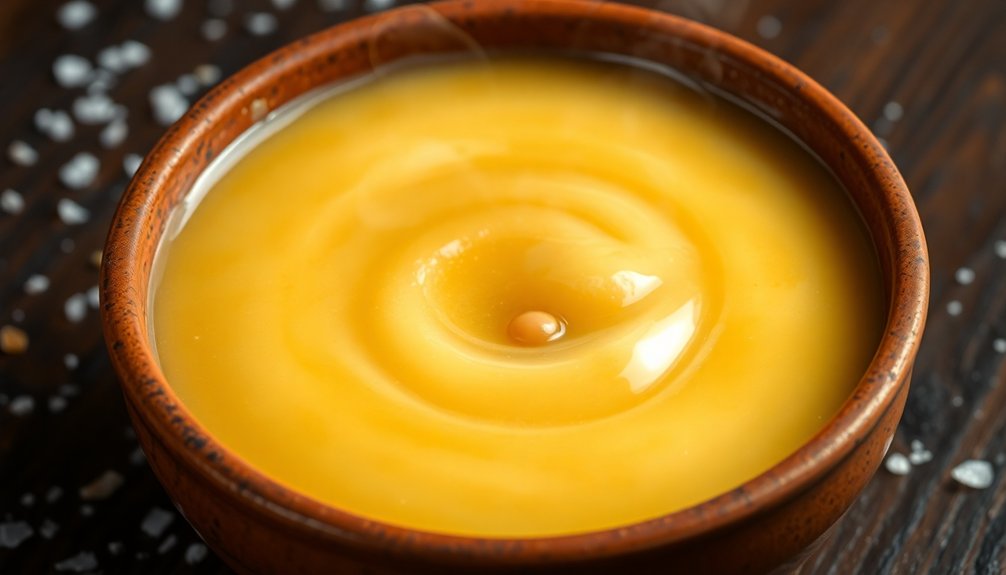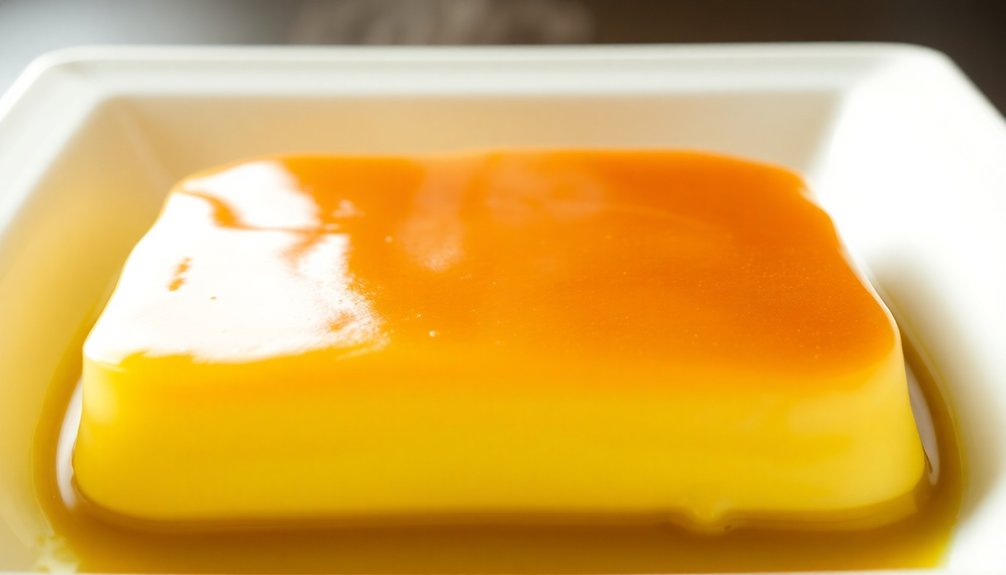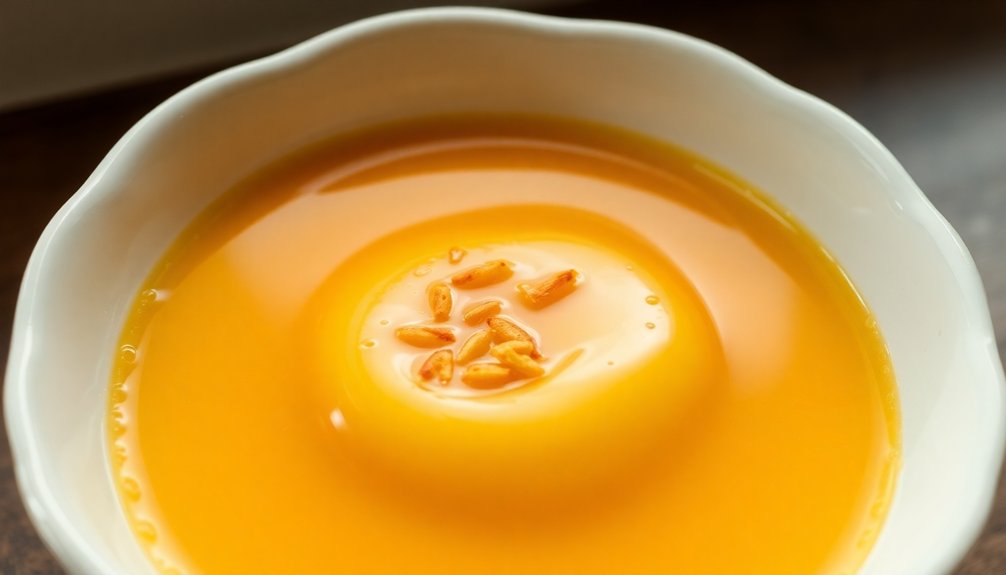How To make Khanom Mo Kaeng - Thai Custard
Khanom Mo Kaeng is a traditional Thai custard that originated in the Ayutthaya period (1350-1767 CE). You'll find this royal dessert combines coconut milk, palm sugar, eggs, and rice flour, baked in clay pots using a water bath method. The custard offers a harmonious blend of flavors with a silky texture when properly prepared. Serve it chilled or at room temperature, garnished with coconut cream for an authentic presentation. The centuries-old techniques reveal Thailand's rich culinary heritage.
Key Takeaways
- Khanom Mo Kaeng is a traditional Thai coconut custard dessert originating from the Ayutthaya period (1350-1767 CE).
- The dessert features a silky texture made from coconut milk, palm sugar, eggs, and rice flour.
- Traditional preparation involves baking in clay pots using a water bath for even cooking.
- The dessert has cultural significance at Thai ceremonies and represents mastery of culinary skill.
- Regional variations exist throughout Thailand while maintaining the essential coconut-palm sugar-egg flavor profile.
History

Although precise records of its origins remain limited, Khanom Mo Kaeng emerged in Thailand during the Ayutthaya period (1350-1767 CE), when Portuguese traders introduced egg-based desserts to the royal court.
This culinary exchange marked a pivotal moment in Thai dessert evolution, blending European techniques with local ingredients like coconut milk and palm sugar.
You'll find the dessert's Thai origins reflected in its name—"Mo Kaeng" refers to the traditional brass pan used in its preparation.
Over centuries, the recipe transcended royal confines to become a staple in households across Thailand.
Its cultural significance extends beyond mere consumption; it frequently appears at merit-making ceremonies, ordinations, and traditional festivals.
The custard represents the harmonious fusion of foreign influence with indigenous Thai culinary wisdom, exemplifying Thailand's adaptive gastronomic heritage.
Recipe

Ingredients
- 3 cups coconut milk
- 1 cup palm sugar
- 5 eggs
- 1/2 cup rice flour
- 1/4 teaspoon salt
- 1 teaspoon jasmine essence or vanilla extract (optional)
- Sliced mung beans or toasted sesame seeds for garnish
Instructions
- Preheat the oven to 350°F (175°C).
- In a saucepan, heat 1 cup of coconut milk with palm sugar over medium heat until the sugar dissolves completely.
- Remove from heat and let it cool slightly.
- In a large bowl, beat the eggs until well mixed.
- Add the rice flour and salt to the eggs and mix well.
- Gradually stir in the remaining coconut milk and the sweetened coconut milk mixture.
- Add jasmine essence or vanilla extract if using.
- Strain the mixture through a fine sieve to remove any lumps.
- Pour the mixture into a baking dish or individual ramekins.
- Place the baking dish in a larger pan with hot water (water bath method).
- Bake for about 45-60 minutes or until the custard is set and the top is golden brown.
- Allow to cool before serving. The custard can be served warm or chilled.
- Garnish with sliced mung beans or toasted sesame seeds before serving.
Cooking Steps

To prepare Khanom Mo Kaeng, you'll start by extracting thick coconut milk and creating a smooth custard mixture with eggs, palm sugar, and flour.
You'll then pour this mixture into a traditional clay pot and bake until the custard sets with a golden-brown surface.
After cooling completely, you'll garnish the dessert with fried shallots or coconut cream before cutting into diamond-shaped pieces for serving.
step 1. Prepare Thick Coconut Milk
Preparing the thick coconut milk, an essential component in Khanom Mo Kaeng, requires precise technique to achieve the proper consistency and richness. You'll need mature coconuts for ideal extraction, as they contain the highest fat content.
First, crack the coconuts and separate the white flesh from the shells. Grate this flesh finely using a traditional grater or food processor.
For the extraction process, combine the grated coconut with warm water (50°C) at a 1:1 ratio. Knead and squeeze the mixture thoroughly through cheesecloth until you've obtained all the liquid.
Allow this first-pressed milk to sit undisturbed for 30 minutes. The thick cream will naturally rise to the top—this is your thick coconut milk. Carefully skim this layer off without disturbing the thinner milk beneath. The milk consistency should resemble heavy cream.
step 2. Prepare Custard Mix
The custard mix forms the heart of Khanom Mo Kaeng, requiring careful attention to proportions and technique for achieving its signature silky-smooth texture.
You'll need to combine your prepared ingredients with precision to guarantee proper custard consistency.
- In a large mixing bowl, whisk palm sugar and eggs until completely incorporated, maintaining a steady rhythm to avoid incorporating excessive air.
- Gradually add the thin coconut milk while continuously whisking to prevent curdling.
- Strain the mixture through a fine-mesh sieve to remove any egg chalaza or sugar lumps.
- Incorporate flavor variations such as pandan extract, taro paste, or corn kernels according to regional preferences.
The resulting mixture should coat the back of a spoon with a thin, even layer—an indication that you've achieved the ideal consistency for traditional Khanom Mo Kaeng.
step 3. Bake in Clay Pot
Baking Khanom Mo Kaeng in traditional clay pots isn't merely a cooking method but an essential technique that imparts distinctive caramelization and authentic earthy notes to this beloved Thai custard.
Preheat your oven to 350°F (175°C). Pour your prepared custard mixture into unglazed clay pots, filling each to about 80% capacity to allow for expansion.
Place the filled pots into a larger baking dish and create a water bath by pouring hot water halfway up the sides of the clay pots. This traditional baking approach guarantees even heat distribution and gentle cooking.
The clay pot benefits include superior heat retention and natural moisture regulation.
Bake for 30-35 minutes until the custard's surface develops a golden-brown finish while maintaining a slightly wobbly center. Allow to cool completely before serving to achieve the ideal texture.
step 4. Cool and Garnish Dessert
Proper cooling constitutes an essential final phase in Khanom Mo Kaeng's preparation, directly influencing both texture and flavor development.
You'll notice the custard's transformation as it cools—firming up while maintaining its characteristic velvety interior. This cooling period allows the dessert's aromatic properties to fully mature.
For ideal dessert presentation, implement these garnishing techniques:
- Remove the custard from the oven and allow it to cool completely at room temperature (approximately 2 hours).
- Apply thin coconut cream drizzle atop the dessert's surface.
- Sprinkle finely chopped spring onions or cilantro for traditional Thai contrast.
- Add a dusting of toasted mung bean flour for texture and visual appeal.
Don't refrigerate before serving as cold temperatures compromise the custard's delicate consistency.
step 5. Cut Into Serving Pieces
Traditional cutting techniques guarantee Khanom Mo Kaeng maintains its structural integrity while achieving visually appealing portions.
First, verify the dessert has cooled completely, as premature cutting will compromise its consistency. Using a sharp knife dipped in warm water between slices, cut the custard into precise rectangular or diamond-shaped pieces—these geometries honor Thai serving techniques while facilitating elegant presentation.
For formal settings, portion sizes typically measure 2×3 inches, while family-style servings may be larger at 3×4 inches.
You'll achieve ideal results by pressing downward with a single, decisive motion rather than sawing, which can create jagged edges. After cutting, carefully lift each piece with a thin spatula, preserving the dessert's distinctive layers.
This meticulous approach respects the custard's delicate texture while showcasing its characteristic caramelization.
Cooking Tips

Three essential techniques will guarantee your Khanom Mo Kaeng achieves the perfect consistency. The traditional cooking techniques require precision in both timing and temperature control.
You'll find success by mastering these fundamental aspects rather than seeking ingredient substitutions, which often compromise authenticity.
- Strain your custard mixture twice before baking to eliminate lumps and guarantee silken texture.
- Maintain consistent oven temperature at 325°F (165°C) throughout the baking process.
- Test doneness by inserting a toothpick—it should emerge mostly clean with slight moisture.
- Allow the custard to cool completely before refrigerating for at least 4 hours to develop ideal flavor compounds.
These methodical approaches preserve the dessert's structural integrity while enhancing its distinctive aromatic profile.
Final Thoughts

Mastery of Khanom Mo Kaeng represents more than culinary skill—it embodies a preservation of Thailand's rich cultural heritage through its gastronomic traditions.
When you perfect this dessert, you're connecting with generations of Thai cooks who've refined its distinctive flavor profile over centuries.
You'll find this versatile dessert adapts well to various serving suggestions: present it at room temperature for casual gatherings or chilled for more formal occasions.
Consider pairing it with fresh fruit or a light tea to balance its sweetness.
While regional variations exist throughout Thailand, the essence remains consistent—a harmonious blend of coconut, palm sugar, and egg that creates something greater than its individual components.
Frequently Asked Questions
How Long Can Thai Custard Be Stored Before Spoiling?
You'll need to consume Thai custard within 3-5 days when refrigerated. Watch for spoilage signs like mold, sour smell, or texture changes. Proper storage tips include airtight containers and consistent refrigeration.
Can I Substitute Coconut Milk With Other Non-Dairy Alternatives?
Looking for coconut alternatives? You can substitute coconut milk with almond, soy, or oat milk in your recipe, though results may vary. These dairy substitutes typically alter flavor profiles and textural properties.
Is Khanom Mo Kaeng Traditionally Served Hot or Cold?
Traditionally, you'll enjoy Khanom Mo Kaeng at room temperature or slightly cooled. This Thai custard solidifies as it cools, creating its distinctive texture. Some serving suggestions include individual portions with a dusting of sesame seeds.
What Dishes Pair Well With Thai Custard?
Like a symphony of sweetness, your Thai custard shines alongside fresh fruits, coconut ice cream, or complementary Thai desserts. You'll find jasmine tea and coffee create exceptional flavor pairings with this traditional delicacy.
Are There Regional Variations of Khanom Mo Kaeng Across Thailand?
You'll find distinct regional differences in this Thai dessert, with northern variants using coconut sugar and southern versions incorporating additional custard ingredients like pumpkin or taro for unique local interpretations.
